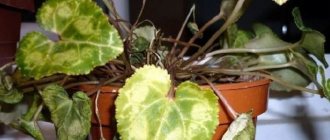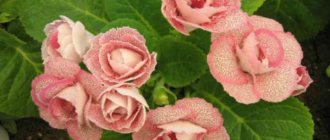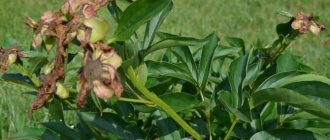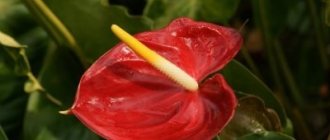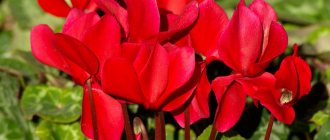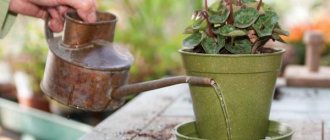Flower growers, both experienced and beginners, compare cyclamen, the color of whose petals range from boiling white to deep purple, with wonderful butterflies fluttering above the dense foliage of a bright green hue. This amazing plant is valued not only for its attractiveness, but also for its variety of varieties and undemanding conditions for growing. The main feature of the alpine violet, as cyclamen is also called, is its flowering time. Bright petals appear on the plant in winter, when all other flowers are dormant.
What kind of plant is this?
ATTENTION : The cyclamen plant belongs to the genus of herbaceous perennials of the Myrsinaceae family, but some scientists believe that it originated from the Primrose family. The plant's name comes from a Latin root meaning "round", like the shape of cyclamen tubers.
Cyclamen is not only a beautiful plant, but also medicinal, because diluted cyclamen juice helps treat sinusitis, but you should be very careful not to burn the mucous membrane (about the medicinal and beneficial properties of cyclamen, chemical composition, as well as contraindications to its use, read here).
Many lovers of growing flowers doubt whether to grow this unique flower, because there is an opinion that it is very whimsical. Don’t believe it, this is all not true, the beautiful cyclamen is unpretentious, loves coolness and partial shade . It, like every plant, has certain requirements; if you fulfill them, it will delight you for many years.
Before getting to know cyclamen better, it is advisable to read information about it in order to know in advance about its properties and needs, so as not to harm the flower in the future and prevent it from dying.
Top dressing
Fertilizers for flowering plants with a complex of all necessary substances are suitable for cyclamen. Fertilize according to the instructions on the package. During dormancy, you should not fertilize the alpine violet. You cannot increase the frequency of feeding, you can only reduce it.
Important! Complex fertilizers already contain all the necessary elements, so they should not be combined with homemade recipes.
Choose fertilizers without nitrogen. It can lead to rotting of the tuber and a decrease in flowering intensity.
When and how long does flowering occur?
When does an indoor flower bloom and how often? If you properly care for cyclamen, it will bloom for a long time and continuously . The flowering period is from autumn to spring; during the entire flowering period, one plant has about 60-70 flowers.
Cyclamen flowers have a wide range of colors, from snow-white to all shades of pink, purple, and burgundy. The leaves of the flower are beautifully heart-shaped and collected in a basal rosette.
It can bloom all year round without going on vacation, or it can please you for just a few months. It blooms abundantly from November to March , later it goes on vacation to gain strength for new flowering.
This plant needs to be properly cared for so that it blooms as long as possible, because proper care is what promotes the flowering of the plant.
Peculiarities
The peculiarity and advantage of cyclamen is its long flowering, which is also very spectacular. During the flowering period, it has a very delicate aroma.
At home, the flower feels quite comfortable; if it is in the right place and is properly cared for , it will thank you with its flowering for quite a long time. In fact, the plant is unpretentious, beautiful, medicinal, which needs to be treated correctly.
IMPORTANT : Cyclamen flowers can be smooth and delicate, or they can be velvety, small and very large, it all depends on the variety of cyclamen, and there are a considerable number of them.
Growing conditions
In order for cyclamen to bloom regularly, the plant is given a certain microclimate, similar to the natural one. Organizing a comfortable temperature regime is one of the more labor-intensive tasks when cultivating crops in an apartment. Flower growers do not have any difficulties in meeting the other requirements of cyclamen.
Temperature and lighting
Exotic needs an abundance of diffused light. But you can’t place the pot on the windowsill of a south-facing window, as the direct rays of the midday sun will leave burns on the tender shoots. Since cyclamen loves fresh air, the room where it grows is systematically ventilated. The plant does not tolerate heat well. A comfortable temperature for it ranges from 10-12 °C, and in winter it is better to lower it to 6 °C. In houses with central heating, this condition is not easy to fulfill.
Humidity
Cyclamen does not need frequent spraying. It tolerates the level of humidity that exists in apartments well. However, if the air is excessively dry, water procedures are rarely carried out. During the flowering period, large drops on the petals can harm the decorative appearance of the plant, causing the development of rot. At this time, use a stationary humidifier or create a foggy cloud over the flower using a fine spray.
Soil and pot
Loose soil is suitable for the plant, which allows air to pass well to the roots, as well as water. Cyclamen prefers a slightly alkaline pH reaction, although it grows well at neutral or slightly acidic levels, but the immunity is slightly weaker. Optimal soil composition: leaf soil, sand, turf, pine needles. The components are taken in the proportion 4: 1: 2: ½. The pot should not be too spacious: this leads to souring of the substrate. When choosing a container, the material is not important. But there should be drainage holes.
How to care?
In order for the plant to bloom and please the eye, you need to know how to properly care for it. First of all, the flower must be protected from drafts . If you decide to place it on the windowsill, then it is advisable that the window there does not open. But surprisingly, it grows remarkably well in a cool room, where it is only 10-12 degrees.
Cyclamen needs light, but direct sunlight is harmful to it.
We talked in detail about the secrets of caring for cyclamen at home in this article.
Pests
Don’t forget that flowers also have pests. Cyclamen is not often attacked by pests and parasites, but the plant can be affected by the cyclamen mite. Signs of damage will be crooked peduncles, curved buds, and curled leaves. In order to prevent the appearance of this pest, the plant should be sprayed with a special pest control drug once a month.
Watering
You need to water the plant in a tray ; you cannot water the plant from above, otherwise the tubers may begin to rot. It is necessary to distribute the moisture evenly so that there is no overflow or, conversely, the earthen ball does not dry out.
Cyclamen should be fed constantly, except during the rest period. Feeding should begin a couple of weeks after purchasing the plant. If you grew cyclamen yourself, you should start fertilizing a week after the sprouts appear.
Before fertilizing, you should make sure that the earthen ball is thoroughly saturated with water. Complex mineral fertilizers are well suited for feeding.
Transfer
Proper replanting also affects flowering . Cyclamen must be replanted very carefully so as not to damage the roots. The plant needs to be transplanted into a low but wide container.
TIP : Until the roots have completely taken root, you should not water very often, and then gradually increase the moisture.
It is very important to create aeration of the cyclamen root system. It is advisable to use a breathable substrate made of coarse-fiber peat. For optimal soil composition, you need equal parts of sand, humus and peat, as well as three parts of leaf soil. To play it safe, soil for cyclamen can be purchased at a special flower shop.
Transplantation should be done in the summer, until the plant blooms . To ensure the transplant goes smoothly, follow these rules:
- before planting, you first need to pour a layer of expanded clay onto the bottom of the pot, then add the prepared soil, place the plant on it and sprinkle the sides with the earthen mixture;
- after transplantation, the upper third of the plant tuber should remain above the ground;
- after transplantation, the plant should be watered after 10-12 days;
- after the transplant has been made, in early September, when young leaves begin to form, the flower must be moved to a cool but sunny place.
Watch a video about the correct transplantation of cyclomen:
Replanting cyclamen
How to transplant
Cyclamen is replanted into a new substrate about once every two years if the pot has become too small for the bulb. This should be done at the end of the dormant period before the start of active growing season.
But remember that cyclamen does not need a spacious pot; it blooms well only in a cramped one, when the layer of earth from the bulb to the wall of the pot is no thicker than 2-3 cm. For example, for a bulb 1-1.5 years old, a pot with a diameter of 7-8 cm is suitable , and for a two to three year old bulb – with a diameter of 14-15 cm.
In a new pot, place expanded clay for drainage, a layer of fresh substrate, then the bulb along with an earthen lump and roots and add enough substrate so that the tuber is two-thirds immersed in it. Compact the soil well. The transplanted cyclamen will need fertilizer no earlier than in a month.
In the photo: Cyclamen flowering
Replanting after purchase
After purchase, cyclamen is replanted only if it is in a dormant period, which in itself is strange - who buys a bulb buried in the soil? If you bought a flowering cyclamen, wait for it to bloom and rest, and then, at the very beginning of the growing season, if the bulb is cramped or you want to change the technical plastic pot to a beautiful one, replant the cyclamen in the manner described. Or, if the plant is doing well in an old pot, it is better to place the ugly pot of cyclamen in a beautiful planter.
Reproduction
With age, the plant grows and the flowers become smaller. To ensure that the plant does not lose the size of its flowers, it should be propagated.
Under indoor conditions, cultivation of cyclamen can last up to 7 years . After this period, the cyclamen is no longer suitable for propagation, so you need to buy a new one. The onion can not be thrown away, but used for medicinal purposes against sinusitis.
Propagating cyclamen is a troublesome business. For industrial purposes, it is propagated using seeds. You can do this yourself by dividing the tuber. But since this is a very difficult task, the easiest way is daughter propagation by a tuber. To do this, you just need to separate the young tuber from the mother one and plant it in a separate container.
All other methods of propagating cyclamen, in particular through seeds, are not effective.
Watering
Water cyclamen when you see that the top layer of soil is dry. You can check dryness with your finger - simply release it into the ground until the phalanx sinks. For unsure gardeners, a humidity indicator is suitable. The frequency of watering depends on the state in which the cyclamen arrives. The young plant is watered more often. Alpine violet does not require much moisture when dormant.
The water temperature should be no more than room temperature. Preferably 2-3 degrees lower.
To settle, take tap water and stir it into a wide-necked vessel. There is no need to close the vessel. Boiled water is not bad at all, but it will not benefit the plant either. Some experienced gardeners use melt water.
Maintenance during the rest period
Cyclamen has faded, what should I do next and how to care for it after flowering? After flowering (late spring), cyclamen begins a dormant period . There are several options for keeping the plant at this time.
ATTENTION : As soon as the leaves begin to turn yellow, reduce watering, preventing the earthen coma from drying out. The pot with the tuber is placed in a cool, shaded place.
Another option for home care to preserve the tubers: after flowering, watering is reduced, and when all the leaves fall off, the pot with the plant is laid on its side. The roots do not die and, in order not to dry out the soil, cyclamen is sometimes watered.
After cyclamen has gone to rest, its bulb cannot be stored in the refrigerator . Otherwise, after the end of the rest, he may not wake up. In order for cyclamen to come out of its “vacation” again, you just need to put it in a dark place, such as a balcony, basement, or simply put it under the bathroom.
During dormancy, it is recommended to water the plant no more than once every 2 weeks. Watering should be done with warm water containing phytohormones, and avoid getting it on the flowers, leaves and bulbs.
Watch a video about caring for cyclamens during the dormant period:
Possible problems
When growing alpine violets at home, sometimes gardeners encounter problems such as diseases and pests that affect cyclamen.
Yellowing of leaves
This happens as a natural process. The leaves turn yellow and wither as the alpine violet prepares for its dormant period. However, this sometimes signals that the plant is over-watered when its roots begin to rot.
Wet rot
The nature of this disease is bacterial. Signs of damage include sudden wilting of foliage and a rotten smell. Unfortunately, it will not be possible to save the alpine violet in this case. Immediately destroy the flower so that it does not infect other plants.
Flying over leaves
Cyclamen leaf blades fall off when there is insufficient air humidity and high temperatures. It is necessary to adjust these parameters to the required ones.
Gray rot
If a silvery coating appears on the leaf blades, this is a sign that gray rot has affected the cyclamen. The cause of this pathology is a fungus that develops quickly when the soil is waterlogged and the room in which the plant is kept is too cold. The affected parts of the flower are carefully removed with a sharp, disinfected knife, and all sections are treated with any fungicidal preparation.
Cyclamen mite
The main problem is that the pest is not easy to detect in the early stages of infection due to its translucent appearance. It attacks cyclamens by sucking out cell sap. The appearance of the pest is caused by increased air humidity and high temperatures. In the first stages, it is eliminated by treating the plants with hot water. If there are a lot of pests, acaricidal drugs are used - “Sunmite”, “Omaita”, “Neoron”. Cyclamen is processed three times. It is advisable to use a different product each time.
Grape weevil
These pests are omnivorous; they feed on seeds, roots, and buds of the plant. To combat them, use any systemic insecticide.
Shchitovka
One of the most dangerous pests of alpine violets, as it is absolutely unaffected by chemicals. It is possible to get rid of scale insects only mechanically. Wipe the areas affected by the pest with a cotton swab soaked in an alcohol solution, and then manually tear the insect off the cyclamen leaves.
Fusarium
It is fungal in nature. The leaves of the alpine violet first turn yellow on one side, subsequently Fusarium wilt spreads to the entire leaf blade, and it dies. Remove the affected parts of the cyclamen and treat the sections with any fungicidal preparation, for example, “Fundazol”.
Aphid
Deformed and curled leaves are the result of the influence of aphid colonies, which drink all the juices from the plant. To destroy the pest, use a solution of laundry or green soap, as well as the chemical preparation “Fitoverm”.
Thrips
The appearance of white dots on the foliage, gradually merging into silvery spots, indicates the presence of thrips on the plant. It is possible to destroy the pest only at the early stage of infection. To do this, they use chemicals - “Aktara” or “Fitoverm”.
Diseases
If your cyclamen leaves turn yellow, but its flowers remain strong and healthy, then you have dry and warm indoor air. You should ventilate the room as often as possible to ensure favorable flowering of your plant.
If your cyclamen begins to rot, the soil may be waterlogged . This is dangerous and the plant may die. Therefore, you need to monitor the plant and water it correctly so that it does not die due to your mistake.
If the plant begins to look sickly, it means your cyclamen has been infected by the cyclamen mite and you should start fighting it as soon as possible.
Try not to overwater the plant so that it does not start to rot; when watering, do not get it on the leaves and flowers; it is advisable to water the cyclamen through a tray.
The cause of disease in a plant may be improper care . If you violate the rules for caring for cyclamen, then it has a greater chance of becoming infected with cyclamen mites or other parasites. To avoid this, you should follow these rules:
- do not place in too hot a place;
- the plant was planted in a large pot;
- the plant was watered not through a tray, but directly onto the tuber;
- the plant has not been fed for a long time or the fertilizer contains a large amount of nitrogen.
Varieties for home cultivation
There are several suitable varieties for home growing:
Persian is the most popular. It is larger than all other species. Flowering from December to May.
European or purple cyclamen - the care for which is slightly different, since it blooms in the fall. Does not shed leaves during winter dormancy.
Ivy-leaved. In warm countries it can grow in open ground, but for the middle zone it is not frost-resistant enough.
Kossky. It is found wild in Bulgaria, Turkey, and the Middle East.
African. It is characterized by the fact that the flower stalks appear before the leaves.
Within each species there are subspecies. For example, among the European variety there are varieties Green Ice, Silver, Album.
It has small pink flowers, up to 2 cm in diameter. The leaves grow from a tuber and have a silvery pattern.
The flowers are pink with lilac stripes. The leaves are glossy with streaks.
Miniature form with white peduncles and dark green leaves with silver streaks.
Lake Garda
A plant with lighter leaves and a dark outline. The flowers are pink.
European cyclamen is easier to care for, reproduces more easily and does not shed its leaves, which makes the flower attractive throughout the year.
